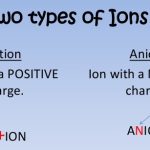Last Updated on 12 months by Francis
Negative ions are atoms or molecules that have gained one or more electrons, giving them a net negative charge. These ions are abundant in nature and can be found in the air we breathe, water we drink, and the earth we walk on. Negative ions are believed to have numerous health benefits, including improving mood, reducing stress, and boosting energy levels. But what are the elements that form negative ions?
In this write-up, we will discuss the fundamental concepts related to negative ions, specifically the elements that make up these charged particles. Negative ions are formed when an atom or a molecule gains one or more electrons. The resultant negatively charged particles can be found both in nature and in controlled environments like ionizers or air purifiers. Let’s delve into the elements that are responsible for forming these negatively charged ions.
Contents
Understanding Negative Ions
Before we dive into the specific elements that form negative ions, it’s important to understand what negative ions are and how they are formed. Negative ions are created when atoms or molecules gain one or more electrons. This can happen through a variety of processes, including radiation, friction, and evaporation. Negative ions can also be produced by natural phenomena such as lightning, waterfalls, and ocean waves.
The Science Behind Negative Ions
Negative ions are negatively charged particles that are produced by the addition of electrons to neutral atoms or molecules. The process of adding electrons to an atom or molecule is called ionization. This can occur naturally through processes such as radiation and lightning, or through artificial means such as ionization machines.
Elements That Form Negative Ions
Now that we have a basic understanding of what negative ions are and how they are formed, let’s explore the specific elements that form negative ions.
Oxygen
Oxygen is one of the most common elements that form negative ions. When oxygen molecules (O2) are exposed to radiation or electrical discharge, they can become ionized, producing negatively charged oxygen ions (O-). These ions are abundant in nature and can be found near waterfalls, in forests, and at the beach.
Chlorine
Chlorine is another element that forms negative ions. Chlorine ions (Cl-) are commonly found in saltwater and are produced by the dissociation of salt (NaCl) in water. Chlorine ions are also produced by the evaporation of seawater, which releases negatively charged chloride ions into the air.
Carbon
Carbon is a versatile element that can form both positive and negative ions. Negatively charged carbon ions (C-) are produced by the ionization of carbon dioxide (CO2) in the atmosphere. These ions are abundant in high-altitude regions and are believed to have numerous health benefits.
Hydrogen
Hydrogen is another element that can form negative ions. Negatively charged hydrogen ions (H-) are produced by the ionization of water molecules (H2O). These ions are abundant in nature and can be found near waterfalls, in forests, and at the beach.
The Benefits of Negative Ions
Negative ions are believed to have numerous health benefits, including improving mood, reducing stress, and boosting energy levels. These benefits are thought to be a result of the ionization of air molecules, which can improve the quality of the air we breathe. Negative ions are also believed to neutralize harmful pollutants and allergens in the air, improving respiratory health.
Key Takeaway: Negative ions are atoms or molecules that have gained one or more electrons, giving them a net negative charge. They are formed through various processes, including radiation, friction, and evaporation, and are abundant in nature. Specific elements that form negative ions include oxygen, chlorine, carbon, and hydrogen. Negative ions are believed to have numerous health benefits, such as improving mood, reducing stress, and boosting energy levels, by improving air quality and reducing stress levels. Some ways to increase negative ions in our environment include spending time in nature, using negative ion generators, and utilizing Himalayan salt lamps and beeswax candles. However, it’s important to be wary of myths about negative ions that are not supported by scientific evidence, and to adopt a holistic approach to improving health and well-being.







